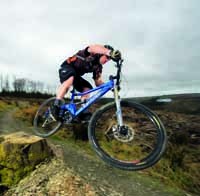 Frame
Frame
The length in the 18in frame makes the cockpit of the 5 roomy enough for all-day rides while adding length to the wheelbase for improved fore-aft stability. It also lets you run the saddle forward for better seated climbing, without feeling penned in. Design wise, Orange has stuck to its folded and seam-welded tubes for the swingarm and down tube, switching to conventional drawn tubes for the top and seat tube. Cable routing goes through the swingarm and while it is a bit of a faff replacing outers or swapping out the rear brake, the full-length gear outer prolongs the life of the gear cable tenfold.
Suspension
Orange has worked closely with Fox to improve the tune of the RP23 rear shock, and the lighter compression makes for a noticeably plusher ride on square-edge hits. The lighter tune also means that you can now make use of the three levels of compression damping the RP23 shock provides. Previously, it was too firm even with the Pro Pedal lever in the 1 position.
Up front it is easy to consider the basic Fox Float R as something of a downgrade, but it is actually the best performing fork on test and definitely gives the Orange an edge as it allows you to ride harder for longer. Steering precision is first rate and a monkey could set it up, so don’t be fooled by the ‘added value’ of extra dials.
Wheels
Hope’s Pro II freehub makes a hell of a racket but it’s solid, reliable and easily serviced. Chances are you’ll still have these hubs on your bike when every other component has been replaced. Keeping it British, the Mini brakes have a positive lever feel with good modulation but they lack bite.
Also, the rear brake pulled straight to the bar on one descent, so it probably has some air in the system from when it was dismantled in order to thread the hose through the swingarm.
Components
All of the finishing kit on the Orange 5 is basic but functional. The 80mm stem complements the reach and the steering response of the bike perfectly, but we’d like to see a wider handlebar than the 25.5in one fitted as standard.
Performance
Climbing is boring at the best of times and it’s no different on the Orange 5. In fact it exhibits more pedal feedback than the Commençal or Cannondale and doesn’t ascend as quickly as the Tomac. That said, it gets the job done with minimal fuss.
Start winding the 5 up on some flowing singletrack or anything that is fun to ride and the bike really comes to life.
Stiffness in the frame gives the Orange a direct link to the terrain that never throws up any surprises. It will lure you dangerously close to the limit but seems to have a knack of letting you know when you are about to push it too far, without leaving you out on a limb.
Perfect weight distribution between the contact patches means that you can put the bike exactly where you want without having to make dramatic changes to your riding position. This means less rider fatigue, letting you keep more in the tank to hit the next section of trail flat out. If you ride for the grin factor, the Orange 5 is the bike of choice for you.
Verdict
At face value the Orange 5 isn’t as stylish as some of the other bikes on test, but once you’ve ridden it you’ll never look at it in the same light again. Handling, stiffness, balance, geometry and reliability don’t come better than on the Orange 5, and together they make for an inspirational bike. Yes, the suspension is simple, but it is also very effective so don’t knock it until you’ve actually tried it. As a package the Orange 5 Pro can be ridden well beyond its design remit, so get yourself a wider bar and be prepared to go eye-wateringly fast.
MBR RATING: 10/10



